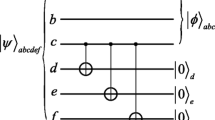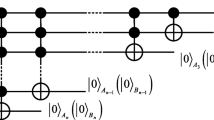Abstract
A scheme of probabilistic teleportation was proposed. In this scheme, we took a six-qubit nonmaximally cluster state as the quantum channel to teleport an unknown three-qubit entangled state. Based on Bob’s three times Bell state measurement (BSM) results, the receiver Bob can by introducing an auxiliary particle and the appropriate transformation to reconstruct the initial state with a certain probability. We found that, the successful transmission probability depend on the absolute value of coefficients of two of six particle cluster state minimum.
Similar content being viewed by others
Explore related subjects
Discover the latest articles, news and stories from top researchers in related subjects.Avoid common mistakes on your manuscript.
1 Introduction
Quantum entanglement is mainly used in the quantum teleportation [1], quantum cryptography [3], and quantum dense coding [2]. Since Bennett et al. [1] original presented a scheme of teleportation, which has attracted much attention and a large number of experiments and theoretical schemes were presented [4–18]. Cao et al. [17, 18] presented two schemes for teleporting an arbitrary n-particle state and multi-particle d-level quantum state, respectively.
In recent years, the cluster entangled states has attracted much attention of the people. The research of the entangled cluster state will help multiparticle entanglement, quantum communication and quantum nonlocality [19–23]. Dong et al. [22, 23] illuminated that the cluster state is a robust violation of reality and decoherence. A lot of teleportation schemes were proposed [24–26], which took four-qubit and five-qubit cluster states as the channel. We have already presented two schemes for teleporting a three-qubit entangled state and a three-atom entangled state [21, 26], respectively.
Recently, in the course of calculating quantum, the six particle cluster states have been achieved by different methods [27–29]. A lot of teleportation schemes have been reported, which took the six particle cluster states as the quantum channel [30, 31]. In the literature [30], Nie demonstrated that the deterministic quantum state sharing of a two-atom state can be realized by the six-atom cluster state.
In the work, a scheme of probabilistic teleportation was presented. We took a six-qubit entangled cluster state as the quantum channel to teleport a three-qubit state in the scheme, and Alice performed three times BSMs and informed Bob of the results. Then, Bob may probabilistic create the initial state by performing the corresponding unitary transformation and introducing an auxiliary particle. We found that, the successful transmission probability depend on the absolute value of coefficients of two of six particle cluster state minimum..
2 Probabilistic Teleporting a Three-Qubit Entangled State
Alice and Bob are the sender and receiver of quantum state, respectively. Suppose Alice has an unknown three-qubit entangled sate, which can be described as follows
where x and yare unknown, meet |x|2+|y|2=1. Alice and Bob share a six-qubit nonmaximally entangled cluster state [32] as follows
where a, b, c and d are unknown meet |a|2+|b|2+|c|2+|d|2=1. Without loss generality, assume |a|>|b|>|c|>|d|, Alice has qubits 1, 2, 3, 4, 8 and 9, and Bob has the rest particles. The whole system can be written as
There are the following three steps in our quantum teleportation scheme.
(1) Alice needs to perform three BSMs on qubit (1, 4), (2, 9) and (3,8) respectively, then the system state can be written as
Where ±1, ±2and ±3 show BSM outcomes corresponding to qubit (1, 4), (2, 9) and (3, 8) respectively. \(\left |{\Psi }^{\pm } \right .\rangle _{ij} \textit {and}\left |{\Phi }^{\pm } \right .\rangle _{ij} \) are
The other 32 cases are zero. The teleportation fails.
(2)Alice need inform Bob of BSM results by means of a classical channel. Then, Bob may reconstruct the initial quantum state.
Suppose Alice’s BSM outcomes are\({}_{38}\left \langle {\psi ^{+}} \right .|{}_{29}\left \langle {\psi ^{+}} \right .|{}_{14}\left \langle {{\Phi }^{+}} \right .|\), and she informs Bob of outcomes. Based on (5), Bob would conclude that the state of qubit 5, 6, 7 collapse into\(\frac {1}{2\sqrt 2} \left ( {bx\left |001 \right .\rangle +cy\left |110 \right .\rangle } \right )_{567} \). In order to create the initial quantum state, Bob need operate \(U_{1} =I_{5} \otimes I_{6} \otimes {\sigma _{7}^{x}} \)on qubits 5, 6 and 7, then he will obtain
(3) For (9), Bob need introduce an assistant qubit A, and the qubit A’s initial state is\(\left |0 \right .\rangle _{A} \). Then, Bob perform the unitary transformation U 2on qubits 5, 6 and 7 as following under the basis of \(\{00\left |00 \right .\rangle _{7A} ,\left |10 \right .\rangle _{7A} ,\left |01 \right .\rangle _{7A} ,\left |11 \right .\rangle _{7A} \}\)
we will get
According to Bob’s measurement results of the qubit A, the quantum teleportation is a failure, if the result is \(\left |1 \right .\rangle _{A} \); otherwise, the teleportation is successfully realized, and qubits 5, 6 and 7 collapse into\(\frac {1}{2\sqrt 2} c\left ( {x\left |000 \right .\rangle +y\left |111 \right .\rangle } \right )_{567} \). At the same time, for Eq. (5), we can easily calculate the successful probability is |c|2.
In the process, Bob need operate the corresponding unitary transformations basing on Alice’s outcomes. The measurement outcomes of Alice, Bob’s state and corresponding transformation U 1 are listed in Table 1, respectively. The all probability is |c|2+|d|2, considering all the cases (64 kinds), which is determined by the absolute value of coefficients of two of six particle cluster state minimum.
3 Conclusion
In the paper, we show that the six qubits nonmaximally cluster states as quantum channel to achieve teleportation of a three qubits state. In the scheme, Alice need perform three times BSMs, and Bob can reconstruct the initinal state by performing the corresponding manipulation and introducing an auxiliary qubit. We found that, the successful transmission probability depend on the absolute value of coefficients of two of six particle cluster state minimum. The device is not perfect, in the experiment, it is impossible to create six particle maximally entangled state. This usually requires using entanglement purification methods to obtain the ideal entangled state, which need more resources. Therefore, our scheme may be more feasible in the experiment.
Change history
29 March 2023
This article has been retracted. Please see the Retraction Notice for more detail: https://doi.org/10.1007/s10773-023-05334-8
References
Bennett, C.H., Brassard, G., Crepeau, C., Jozsa, R., Peres, A., Wooters, W.K.: Phys. Rev. Lett. 70, 1895 (1993)
Bennett, C.H., Wiesner, S.J.: Phys. Rev. Lett. 69, 2881 (1992)
Ekert, A. K.: Phys. Rev. Lett. 67, 661 (1991)
Wang, X. W., Yang, G. J.: Phys. Rev. A 79, 062315 (2009)
Zhang X H, Yang Z Y, Xu, P P.: Chin. Sci. Bull. 54, 2991 (2009)
Boschi, D., Branca, S., De Martini, F., Hardy, L., Popescu, S.: Phys. Rev. Lett. 80, 1121 (1998)
Karlsson, A., Bourennane, M.: Phys. Rev. A 58, 4394 (1998)
Agrawal, P., Pati, A.: Phys. Rev. A 74, 062320 (2006)
Briegel, H.J., Raussendorf, R.: Phys. Rev. Lett. A 86, 910 (2001)
Nie, Y.Y., Hong, Z.H., Huang, Y.B., Yi, X.J., Li, S.S.: Int. J. Theor. Phys. 48, 1485 (2009)
Choudhury S., Muralidharan S, Panigrahi P K.: J. Phys. A 42, 115303 (2009)
Mei, F., Yu, Y.F., Zhang, Z.M.: Chin. Phys. B 19, 020308 (2010)
Wang, X.W., Peng, Z.H., Jia, C.X., Wang, Y.H., Liu, X.J.: Opt. Commun. 282, 670 (2009)
Bouwmeester, D., Pan, J.W., Mattle, K., Eibl, M., Weinfurter, H., Zeilinger, A.: Nature 390, 575 (1997)
Furusawa, A., Sorensen, J.L., Braunstein, S.L., Fuchs, C.A., Kimble, H.J., Polzik, E.S.: Science 282, 706 (1998)
Nielsen, M. A., Knill, E., Laflamme, R.: Nature 396, 52 (1998)
Cao, M., Zhu, S. Q.: Commun. Theor. Phys. 43, 69 (2005)
Cao, M., Zhu, S. Q.: Commun. Theor. Phys. 43, 803 (2005)
Dür, W., Vidal, G., Cirac, J.I.: Phys. Rev. A 62, 062314 (2000)
Shi, B. S., Jiang, Y. K., Guo, G. C.: Phys. Lett. A 268, 161 (2000)
Yu, L. Z., Wu, T.: Commun. Theor. Phys. 59, 700 (2013)
Dong, P., Xue, Z. Y., Yang, M., Cao, Z. L.: Phys. Rev. A 73, 033818 (2006)
Hein, M., Dur, W., Briegel, H.J.: Phys. Rev. A 71, 032350 (2005)
Han, L.F., Xu, H. F.: Int. J. Theor. Phys. 51, 2540 (2012)
Nie, Y.Y., Li, Y. H., Jin, C. P., Liu, J. C., Sang, M. H.: Int. J. Theor. Phys. 50, 2799 (2011)
Yu, L. Z., Wu, T.: Int. J. Theor. Phys. 52, 1461 (2013)
Gao, W. B., Xu, P., Yao, X. C., Guhne, O., Cabello, A., Lu, C. Y., Peng, C. Z., Chen, Z. B., Pan, J. W.: Phys. Rev. Lett. 104, 020501 (2010)
Ceccarelli, R., Vallone, G., Martini, F. D., Mattaponi, P., Cabello, A.: Phys. Rev. Lett. 103, 160401 (2009)
Vallone, G., Donati, G., Ceccarelli, R., Mataloni, P.: Phys. Rev. A 81, 052301 (2010)
Nie, Y. Y., Li, Y. H., Liu J. C., Sang M. H.: Int. J. Theor. Phys. 5, 2526 (2011)
Nie, Y. Y., Sang M. H., Li, Y. H., Liu J. C.: Int. J. Theor. Phys. 5, 1367 (2011)
Lu, C.Y., Zhou, X.Q., Ghne, O., Gao, W. B., Zhang, J., Yuan, Z. S., Goebel, A., Yang, T., Pan, J. W.: Nat. Phys. 3, 91 (2007)
Acknowledgments
The Talent Foundation of Anhui Provincial Higher Education Nos. 2013SQRL135ZD, 2013A205
Author information
Authors and Affiliations
Corresponding author
About this article
Cite this article
Yu, Lz., Sun, Sx. RETRACTED ARTICLE: Teleportation of Three-Qubit State via Six-qubit Cluster State. Int J Theor Phys 54, 1600–1603 (2015). https://doi.org/10.1007/s10773-014-2360-x
Received:
Accepted:
Published:
Issue Date:
DOI: https://doi.org/10.1007/s10773-014-2360-x




